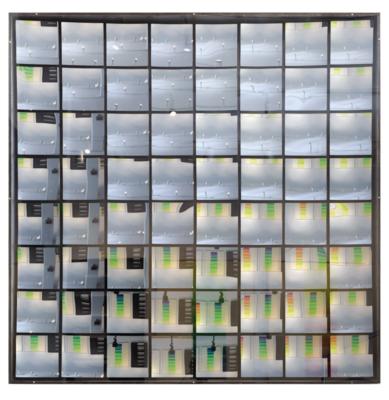Adolf Luther *
(Uerdingen 1912–1990 Krefeld)
Concave Mirror Object, 1976, signed, dated on the reverse Luther 76 and stamps in red “Licht und Materie” and “Sehen ist schön”, 8 x 8 blue-silver square mirrors, plexiglass, wooden plate, 152 x 152 x 14.5 cm, in plexiglass box
Provenance:
The artist
Mönchehaus Museum Goslar - acquired from the artist
Exhibited:
Goslar, JUNIOR-Galerie, Adolf Luther - Licht + Materie, Retrospective 1958 – 1977, 1977
Goslar, Mönchehaus Museum, Adolf Luther, Licht und Materie,
12 November 1978 – 30 April 1979
Goslar, Mönchehaus Museum, Adolf Luther, Licht und Materie,
29 April - 4 October 1992
Goslar, Mönchehaus Museum, Adolf Luther, Licht und Materie, permanent exhibition, 1997 – 2004
Goslar, Mönchehaus Museum, On – light, Adolf Luther und sein Umkreis, 11 May - 30 June 2013
Krefeld 1961. Adolf Luther smashes glass bottles in his backyard. He smashed them with a hatchet or threw them against the wall. This action of destruction - or dematerialisation, as he later called it, gave Luther the solution to his long artistic quest: when he smashed the glass bottles, light became visible at the edges of the fragments, even if only for a few seconds - light as an independent phenomenon, independent of material reality.
From the mid-1960s, Luther began to replace the glass fragments of these first light objects with concave and convex concave mirrors, lenses and prisms: “The light energy rushing through the space carries images with it. I consider light to be a transoptical substance that can carry images of unlimited scope.”
Dieter Honisch. Licht und Materie. Eine Übersicht über das Lebenswerk mit Selbstzeugnissen des Künstlers, Recklinghausen 1978, n.p.
His words refer to the concave mirror objects that reflect countless images and produce immaterial light phenomena in space. Like the two works on view here, which, although not designed as diptychs per se, nevertheless complement each other in their now convex form, directly reflecting us, and now concave, upside-down form: “Their instrumental function consists in the fact that the many identical concave mirrors, on the one hand, multiply a given reality into a multitude of alien-seeming appearances, often inverted and irritating to the viewer, and that, on the other hand, they create a kind of pure phenomenality, thus transforming space itself into an otherwise invisible, light-filled realm of energy.”
Max Imdahl, Erläuterungen zur Modernen Kunst, Düsseldorf 1992, p. 155
Esperta: Dr. Petra Maria Schäpers
 Dr. Petra Maria Schäpers
Dr. Petra Maria Schäpers
+49 211 2107747
petra.schaepers@dorotheum.de
29.11.2023 - 18:00
- Prezzo realizzato: **
-
EUR 84.500,-
- Stima:
-
EUR 50.000,- a EUR 70.000,-
Adolf Luther *
(Uerdingen 1912–1990 Krefeld)
Concave Mirror Object, 1976, signed, dated on the reverse Luther 76 and stamps in red “Licht und Materie” and “Sehen ist schön”, 8 x 8 blue-silver square mirrors, plexiglass, wooden plate, 152 x 152 x 14.5 cm, in plexiglass box
Provenance:
The artist
Mönchehaus Museum Goslar - acquired from the artist
Exhibited:
Goslar, JUNIOR-Galerie, Adolf Luther - Licht + Materie, Retrospective 1958 – 1977, 1977
Goslar, Mönchehaus Museum, Adolf Luther, Licht und Materie,
12 November 1978 – 30 April 1979
Goslar, Mönchehaus Museum, Adolf Luther, Licht und Materie,
29 April - 4 October 1992
Goslar, Mönchehaus Museum, Adolf Luther, Licht und Materie, permanent exhibition, 1997 – 2004
Goslar, Mönchehaus Museum, On – light, Adolf Luther und sein Umkreis, 11 May - 30 June 2013
Krefeld 1961. Adolf Luther smashes glass bottles in his backyard. He smashed them with a hatchet or threw them against the wall. This action of destruction - or dematerialisation, as he later called it, gave Luther the solution to his long artistic quest: when he smashed the glass bottles, light became visible at the edges of the fragments, even if only for a few seconds - light as an independent phenomenon, independent of material reality.
From the mid-1960s, Luther began to replace the glass fragments of these first light objects with concave and convex concave mirrors, lenses and prisms: “The light energy rushing through the space carries images with it. I consider light to be a transoptical substance that can carry images of unlimited scope.”
Dieter Honisch. Licht und Materie. Eine Übersicht über das Lebenswerk mit Selbstzeugnissen des Künstlers, Recklinghausen 1978, n.p.
His words refer to the concave mirror objects that reflect countless images and produce immaterial light phenomena in space. Like the two works on view here, which, although not designed as diptychs per se, nevertheless complement each other in their now convex form, directly reflecting us, and now concave, upside-down form: “Their instrumental function consists in the fact that the many identical concave mirrors, on the one hand, multiply a given reality into a multitude of alien-seeming appearances, often inverted and irritating to the viewer, and that, on the other hand, they create a kind of pure phenomenality, thus transforming space itself into an otherwise invisible, light-filled realm of energy.”
Max Imdahl, Erläuterungen zur Modernen Kunst, Düsseldorf 1992, p. 155
Esperta: Dr. Petra Maria Schäpers
 Dr. Petra Maria Schäpers
Dr. Petra Maria Schäpers
+49 211 2107747
petra.schaepers@dorotheum.de
|
Hotline dell'acquirente
lun-ven: 10.00 - 17.00
kundendienst@dorotheum.at +43 1 515 60 200 |
| Asta: | Arte contemporanea I |
| Tipo d'asta: | Asta in sala con Live Bidding |
| Data: | 29.11.2023 - 18:00 |
| Luogo dell'asta: | Wien | Palais Dorotheum |
| Esposizione: | 18.11. - 29.11.2023 |
** Prezzo d’acquisto comprensivo dei diritti d’asta acquirente e IVA
Non è più possibile effettuare un ordine di acquisto su Internet. L'asta è in preparazione o è già stata eseguita.

